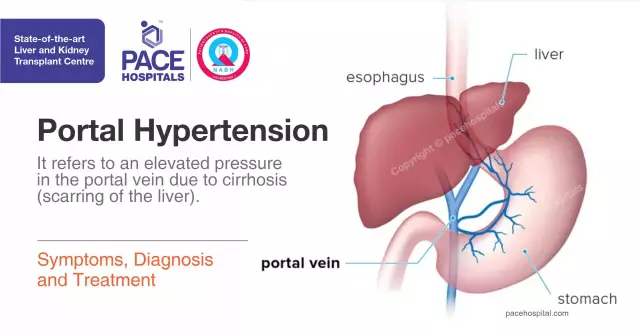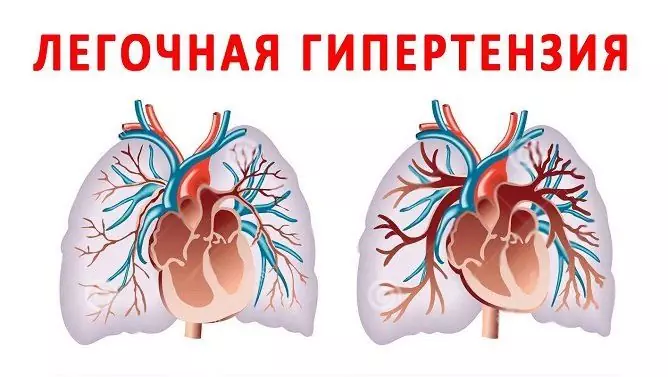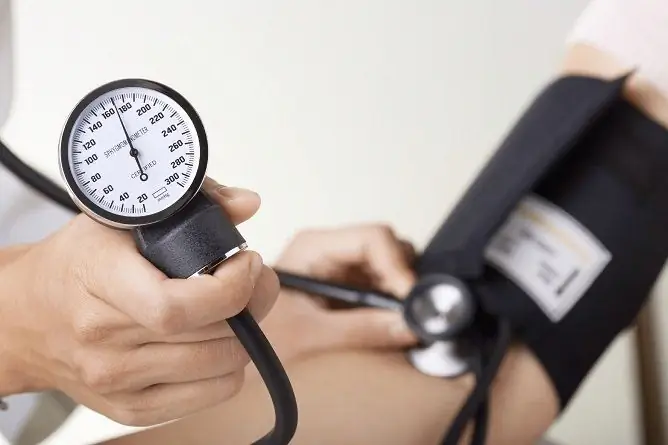- Author Rachel Wainwright [email protected].
- Public 2023-12-15 07:39.
- Last modified 2025-11-02 20:14.
Portal hypertension

Portal hypertension is a disturbance in the normal blood flow in the portal vessels, the hepatic and inferior vena cava, which leads to increased hydrostatic pressure in the portal vein. This disease occurs in both adults and children, and occurs most often due to cirrhosis of the liver. It can be accompanied by varicose veins of the stomach and esophagus, splenomegaly, ascites, bleeding disorders towards hypocoagulation, and other symptoms and syndromes.
Gastrointestinal bleeding and hepatic coma are the most dangerous complications of portal liver hypertension.
Etiology of portal hypertension
Portal hypertension syndrome is not an independent disease, but clinical manifestations of various pathologies, in accordance with the nature of which prehepatic, intrahepatic and posthepatic types of portal hypertension are distinguished.
The prehepatic form includes:
- Congenital malformation of the portal vein;
- Overgrowth of the lumen of the entire vein or its individual section;
- Pressure on veins with tumor-like or inflammatory infiltration and cysts;
- Mechanical damage to the portal vein;
- Liver surgery.
The causes of internal portal hypertension of the liver can be almost all existing acute and chronic diseases affecting this organ:
- Primary biliary cirrhosis;
- Sclerotic scarring of the liver tissue;
- Rheumatoid arthritis;
- Acute alcoholic hepatitis;
- Felty's syndrome;
- Congenital liver fibrosis;
- Wilson's disease;
- Caroli's disease;
- Gaucher disease;
- Alveococcosis;
- Hemochromatosis;
- Schistosomiasis;
- Sarcoidosis;
- Polycystic liver disease;
- Tumors;
- Myeloproliferative diseases;
- Vitamin A intoxication;
- Taking medications;
- Intoxication with vinyl chloride, arsenic, copper.
Post-hepatic portal hypertension is caused by blockage of blood in the veins of the liver for the following reasons:
- Chiari malformation - complete or partial obstruction of the veins;
- Thrombosis of the inferior vena cava - tumors and cysts;
- Cardiac disorders - tricuspid valve insufficiency, constrictive pericarditis.
Portal hypertension symptoms
Symptoms of portal hypertension are associated with the underlying disease causing the high pressure in the portal vein system.
The prehepatic form often occurs during childhood and generally has a favorable prognosis. Most often it is accompanied by bleeding from the esophageal veins, splenomegaly, hypersplenism, portal vein thrombosis. In some patients, the portal vein is replaced by a network of small dilated veins.
For the intrahepatic type of portal hypertension, signs of cirrhosis are characteristic. The course of the disease depends on what type of cirrhosis belongs to (atrophic, postnecrotic, biliary or pigmentary), as well as on the degree of compensation for liver dysfunctions and the activity of the pathological process. Patients have hemorrhagic complications, splenomegaly, varicose veins of the anterior abdominal wall, ascites. Dilated veins are prone to rupture, leading to bleeding. In this case, vomiting of blood occurs without pain in the epigastrium. If blood flows into the stomach, the vomit is the color of coffee grounds. Posthemorrhagic anemia develops rapidly. The first bleeding from the veins of the esophagus is fatal in 30% of cases. With advanced cirrhosis, damage to the liver parenchyma causes ascites and Gospell's disease. In these cases, as conservative,and surgical treatment of portal hypertension may not be successful.
The post-hepatic form of the syndrome in the acute stage is accompanied by severe pain in the right hypochondrium and epigastric region. Hyperthermia, hepatomegaly and ascites rapidly increase. Death occurs as a result of hepatic renal failure and profuse bleeding from the esophageal veins. In the chronic stage of the disease, hepatomegaly and splenomegaly develop gradually. A collateral venous network appears on the anterior abdominal wall. Depletion and hypoalbuminemia (protein metabolism disorders) are observed.
Diagnostics and treatment of portal hypertension
Diagnosis of portal hypertension syndrome is carried out by a hepatologist, gastroenterologist or oncologist using an ultrasound examination of the abdominal cavity. It shows enlargement of the spleen and liver, and also reveals fluid accumulation and changes in the diameter of the portal and splenic veins.
If portal hypertension is suspected, fibrogastroduodenoscopy (FGDS) is necessary to assess the condition of the esophageal veins and detect gastrointestinal bleeding. Varicose veins of the gastrointestinal tract are established using contrast radiography. In addition to these studies, a general urine test and a biochemical blood test are performed.

Treatment for portal hypertension can be conservative or surgical. It is aimed primarily at eliminating the initial disease and preventing bleeding in the gastrointestinal tract.
Some doctors use nitrates and beta-blockers, but most often they resort to surgery, especially for ascites, severe liver failure, and rapid expansion of gastric veins. Surgical intervention consists of creating new pathways for the outflow of blood and in the drainage of fluid from the abdominal cavity. In this case, it is important to regulate the rate of the process, since with intense dehydration, a hepatic coma can develop. In some cases, a liver transplant is necessary.
Portal hypertension is not completely cured. Any methods give only a temporary effect, and the disease in most cases returns. But without treatment, the life of patients is sharply reduced and averages 1.5 years. Therefore, the correct therapy of liver diseases and the timely diagnosis of portal hypertension are extremely important.
YouTube video related to the article:
The information is generalized and provided for informational purposes only. At the first sign of illness, see your doctor. Self-medication is hazardous to health!






